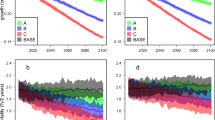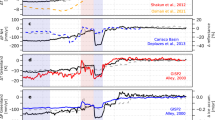Abstract.
Numerous analyses of the possible impacts of future climatic changes on tree species composition have been published for both lowland and high-elevation forests. Most of these studies were based on the application of forest "gap" models, and the vast majority of them considered only changes in the average of climatic parameters over time. In this study, we use a unique data set on reconstructed past climatic variations to analyse forest dynamics simulated by the forest gap model ForClim. This analysis forms the basis for a systematic exploration of the ecological effects of changing means vs. changing variability of climate on central European forests. A reconstruction of historical climate covering the last 470 years in the Swiss lowlands (ClimIndex) is extrapolated to a transect across the alpine (cold) treeline and used to simulate the influence of climate variations on the time scale of decades on forest biomass and tree species composition at both sites. While the simulation at the low-elevation site shows little sensitivity to climate variations, the results from upper subalpine forests suggest that two major dieback events would have occurred at elevations above the current but below the climatic tree line, induced by clusters of exceptionally cold summers. The results are in agreement with available dendrochronological data and with documentary evidence on massive negative impacts on flora and fauna at high elevations during these periods. We conclude that ForClim is capable of capturing the effects on tree population dynamics of climate variability at these sites as reconstructed from the ClimIndex record. A factorial design is used to address the sensitivity of ForClim to changes of the long-term averages vs. changes of the variability of monthly temperature and precipitation data. To this end, the simulated tree species composition of near-natural forests is examined along a climate gradient in Europe. The results indicate that there are three types of forest response: (1) little sensitivity to both kinds of change, (2) strong sensitivity to changes in the means, but little sensitivity to changing variability, and (3) strong sensitivity to changing variability at least in parts of the examined climate space. Half of the cases investigated fall under the third category, suggesting that emphasis should be placed on also assessing the sensitivity of ecosystems to future changes in climate variability rather than on changes of average values alone.
Similar content being viewed by others
Author information
Authors and Affiliations
Additional information
Electronic Publication
Rights and permissions
About this article
Cite this article
Bugmann, H., Pfister, C. Impacts of interannual climate variability on past and future forest composition. Reg Environ Change 1, 112–125 (2000). https://doi.org/10.1007/s101130000015
Received:
Accepted:
Issue Date:
DOI: https://doi.org/10.1007/s101130000015




